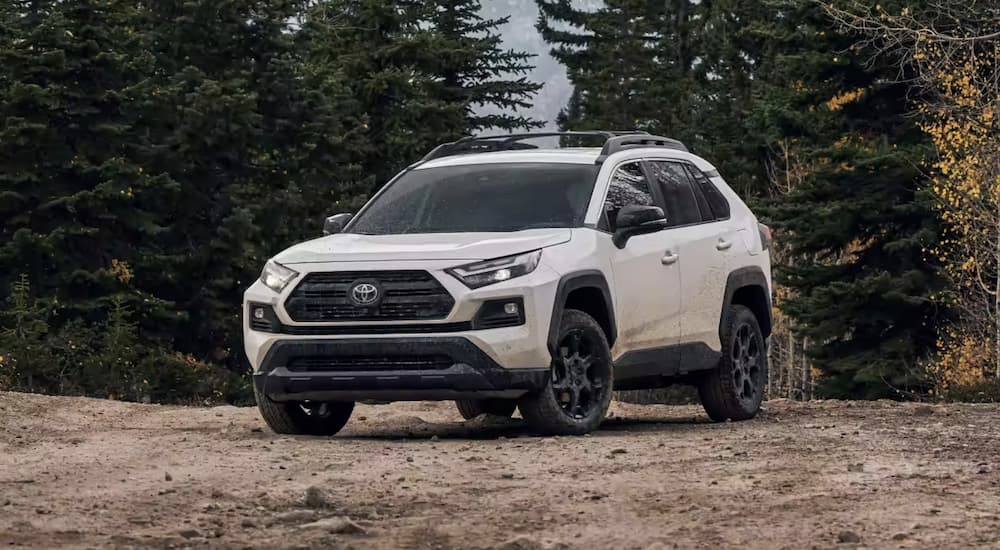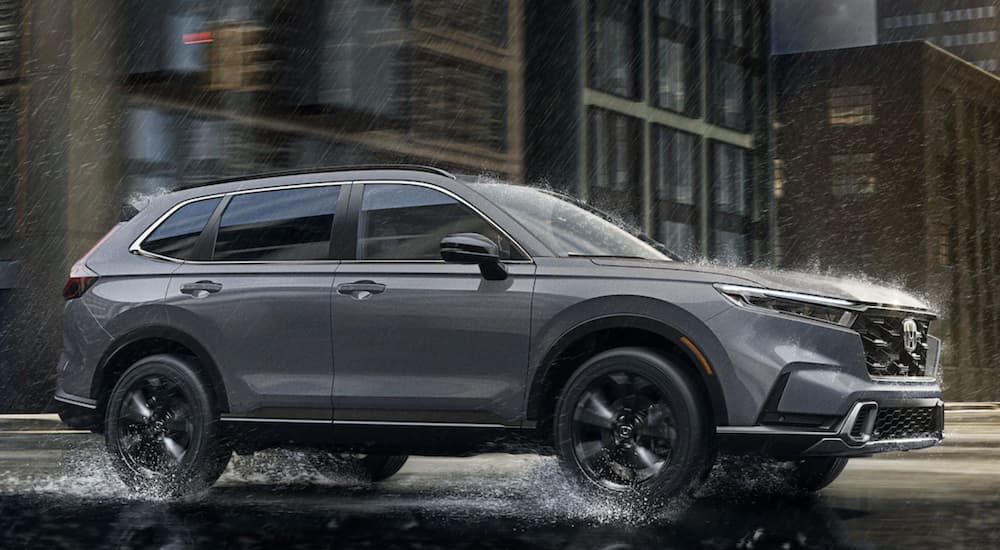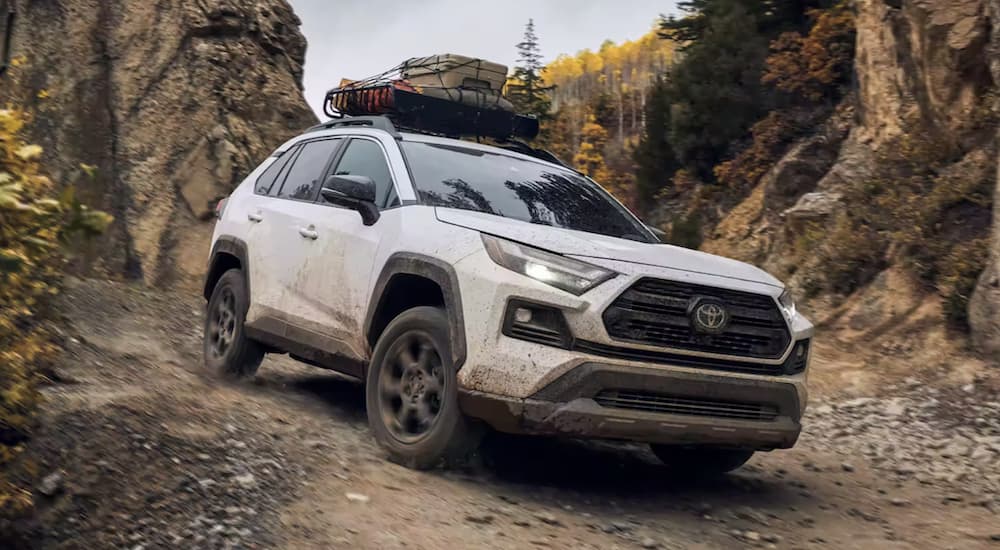You’re looking for a compact SUV that doesn’t require you to sacrifice size or agility for performance or efficiency. You want the best of both worlds and deserve it; at least, that’s what Toyota thinks. Never having to settle for less is the foundation on which the best-selling RAV4 is built, but appreciating that requires comparing it with its biggest rival––the Honda CR-V.
Looking at the 2022 Toyota RAV4 vs 2022 Honda CR-V reveals many similarities. The compact SUVs are both affordably priced, with the RAV4 slightly cheaper at $26,975 compared to the $26,800 CR-V. The models are also incredibly efficient, offering a combined fuel economy of 30 MPG that will save you money at the pump. They also boast the latest technology, from expansive touchscreen displays to advanced driver-assist and safety features. However, that’s where the similarities end.
The 2022 RAV4 takes the lead in every other category, especially when looking at its capable powertrain and diverse lineup that includes everything from the entry-level LE to the adventurous TRD Off-Road. The CR-V can’t compete, pigeonholing itself as a compact SUV forever known for its pragmatic design. How else do the models differ, and what makes the 2022 Toyota RAV4 a better option? Let’s find out.
Looking Under the Hood: Performance and Capability
The 2022 Toyota RAV4 and 2022 Honda CR-V offer a single engine lineup, but how these engines perform is vastly different. Honda’s 1.5L turbocharged four-cylinder might boast the “turbocharged” name, but it doesn’t live up to its potential and churns out only 190 horsepower and 179 lb-ft of torque. Unfortunately, this isn’t enough power to give the CR-V an engaging driving dynamic, leaving a lot to be desired in the driver’s seat.
Honda pairs its turbocharged four-cylinder to a continuously variable transmission, a trademark of the Honda lineup. While the CVT is often praised for balancing power delivery with efficiency, this type of transmission is more complex and has a history of issues that make the CR-V more expensive to own and maintain. Even then, the CVT doesn’t dramatically impact the CR-V’s fuel economy, with the all-wheel drive model averaging 27 MPG in the city and 32 MPG on the highway. The RAV4 is slightly more efficient, with its highway average at 34 MPG for all-wheel models.
The RAV4’s higher fuel economy is only one advantage the Toyota has over the Honda. The Honda’s turbocharged four-cylinder lags behind the RAV4’s standard 2.5L engine and eight-speed automatic transmission, delivering a broader gear range, smoother shift patterns, and more responsive handling. The result is phenomenal, with the RAV4’s engine producing 203 horsepower, 184 lb-ft of torque, and a maximum towing capability of 3,500 pounds. With the CR-V only able to tow 1,500 pounds, there’s no question that the RAV4 is a must if you’re looking to tow a small trailer.
From Practical to Adventurous: Trims
Honda will forever be known for its practical lineup, and the 2022 CR-V is no exception. The CR-V’s four-trim lineup runs the gamut, from the entry-level LX to the top-tier Touring. The trims (LX, Special Edition, EX, EX-L, and Touring) offer a progressive suite of features and technology. Still, none offer the capability or diversity you’ll find in the Toyota RAV4’s lineup. What do I mean?
The CR-V LX starts the lineup and comes standard with the Honda Sensing suite of safety and driver-assist features, a 60-40 split rear seat, Bluetooth capability, and 17-inch alloy wheels. The RAV4’s entry-level LE adds more value and comes with smartphone integration via Android Auto and Apple CarPlay, Amazon Alexa compatibility, LED daytime running lights, the Toyota Safety Sense 2.0 suite, and a trial to Toyota’s Safety Connect services. These entry-level trims lay the foundation for each lineup, but there’s a notable difference beyond value.
Where the CR-V focuses on practicality, the RAV-4 delivers diversity. For example, the CR-V’s top-tier Touring trim is outfitted with a wireless phone charger, 19-inch wheels, a hands-free access power tailgate, and Honda’s real-time all-wheel drive system. While the all-wheel drive system enhances the CR-V’s on-road capability, it’s designed only for slippery conditions and not for adventures. That’s where the RAV4 gains a significant advantage.
The RAV4 builds on Toyota’s history of going beyond the pavement and offers several unique trims like the Adventure and TRD Off-Road. The Adventure features Toyota’s Dynamic Torque Vectoring All-Wheel Drive system and comes with 19-inch wheels. The Adventure is more comparable to the CR-V Touring, while the TRD Off-Road likens itself to the hearty 4Runner and Tacoma of Toyota fame. The RAV4 TRD Off-Road adds exclusive 18-inch TRD wheels and the all-wheel drive system but goes one step further. The trim comes with a TRD-tuned independent MacPherson strut suspension with a front stabilizer bar and a multi-link rear suspension with a rear stabilizer bar for improved off-road handling.
A Virtual Spotter: Safety and Driver-Assist Features
Toyota and Honda prioritize safety and outfit the RAV4 and CR-V with advanced safety and driver-assist features that optimize your focus, increase your awareness, and minimize the likelihood of a collision. The automakers take similar approaches, with Honda outfitting the CR-V with its Honda Sensing Suite and Toyota equipping the RAV4 with Toyota Safety Sense 2.0. But how do the suites differ, and which suite is more comprehensive?
The Honda Sensing Suite comes standard across the CR-V’s lineup and adds exceptional value to the compact SUV. The suite includes Honda’s Collision Mitigation Braking System, Adaptive Cruise Control with Low-Speed Follow, Lane Keeping Assist System, Road Departure Mitigation System, and Multi-Angle Rearview Camera. Having Honda keep an eye on your blind spots requires upgrading to a top-tier trim, which adds Blind Spot Information with Cross Traffic Monitor to the Honda Sensing Suite.
The RAV4’s Toyota Safety Sense 2.0 suite is more comprehensive and advanced, expertly monitoring the sides, front, and rear of the SUV. For example, the Pre-Collision System with Pedestrian Detection relies on a camera and radar to look for vehicles and pedestrians, alerting you with visual and audible cues. If you fail to respond, the system automatically applies the brakes, helping you avoid or minimize the impact.
The suite also includes Full-Speed Range Dynamic Radar Cruise Control, which is comparable to Honda’s Adaptive Cruise Control with Low-Speed Follow. However, the RAV4’s technology has one significant advantage and can work in stop-and-go conditions, bringing the SUV to a controlled stop to help you navigate rush hour traffic. Other features in the suite include automatic high beams, Lane Departure Warning with Steering Assist, Lane Tracing Assist that works with Toyota’s Dynamic Radar Cruise Control, and Road Sign Assist.
Connected and Informed: Technology
Technology is another critical difference between the 2022 CR-V and 2022 RAV4, with Toyota again leading the race as Honda focuses more on practicality and offers nominal convenience. This focus is immediately apparent in the CR-V’s smaller center touchscreen display, which comes as a standard five-inch display or an available seven-inch display. The RAV4’s standard seven-inch display is noticeably larger and more intuitive and is only bettered by the nine-inch upgrade.
For Honda, smartphone integration doesn’t come standard on every trim, so you’ll have to upgrade to the CR-V Special Edition to enjoy the convenience of Apple CarPlay or Android Auto integration. Toyota makes this a standard feature across the lineup, adding wireless phone charging, remote access, and a seven-inch multi-information display for the driver. You’ll have to upgrade to a top-tier trim like the CR-V Touring to enjoy wireless charging and other comparable amenities.
The RAV4 further distinguishes itself with its digital rearview mirror, a stark contrast to the CR-V’s traditional rearview mirror and standard rear camera system. The RAV4’s digital rearview mirror gives you a more expansive real-time view behind the SUV and can easily be adjusted back to the traditional mirror via a convenient toggle switch. Unfortunately, the CR-V doesn’t offer anything comparable, forcing you to rely on the conventional setup and the CR-V’s limited rearview camera via the smaller touchscreen display.
Honda and Toyota level the playing field with their remote connectivity features via Toyota’s Connected Services and the HondaLink system. These tools give you remote access to the SUVs via your smartphone, allowing you to remotely start the engine, honk the horn, flash the lights, and lock or unlock the doors. The apps also give you access to vehicle diagnostics that make it easy to protect your investment by scheduling routine maintenance visits from the convenience of your phone.
Toyota’s Victory Lap
The 2022 Toyota RAV4 and 2022 Honda CR-V are two of the best-selling compact SUVs in the segment. While they share many similarities, their differences are significant and put the RAV4 legions ahead of the competition. From adventurous and off-road ready trims to capable powertrains and a long list of standard safety, driver-assist, and connectivity features, there’s no question how the 2022 Toyota RAV4 earns its victory lap.






